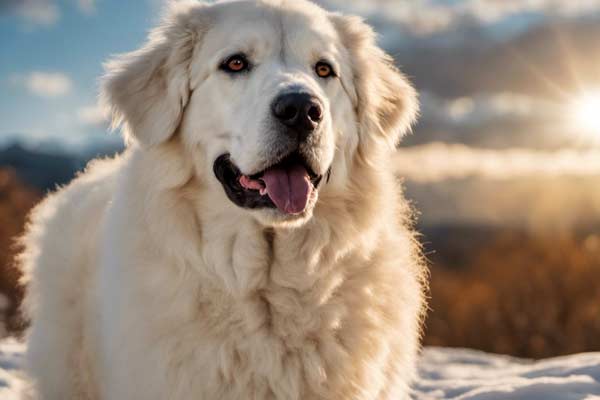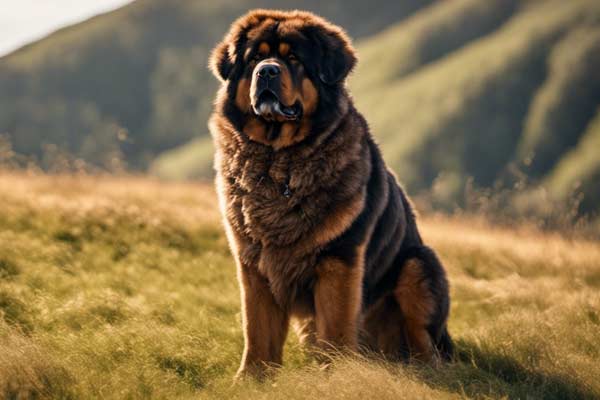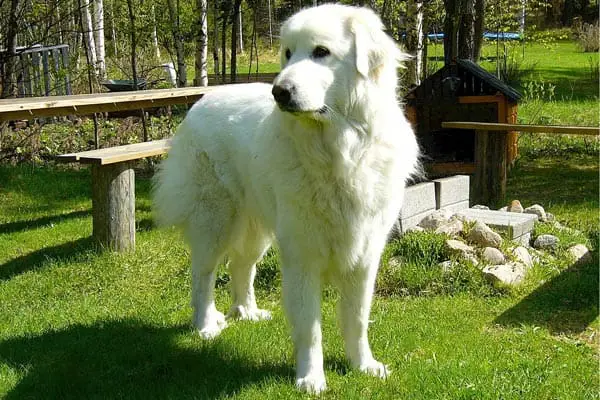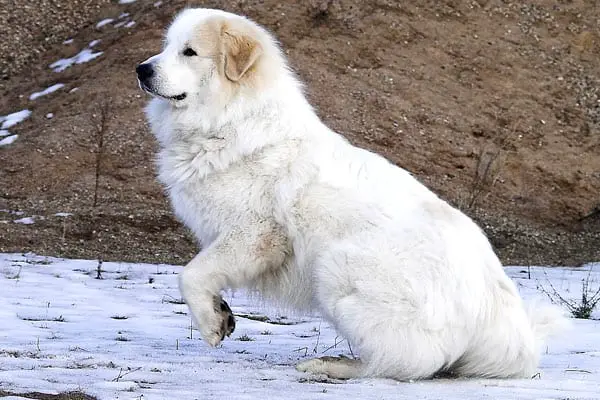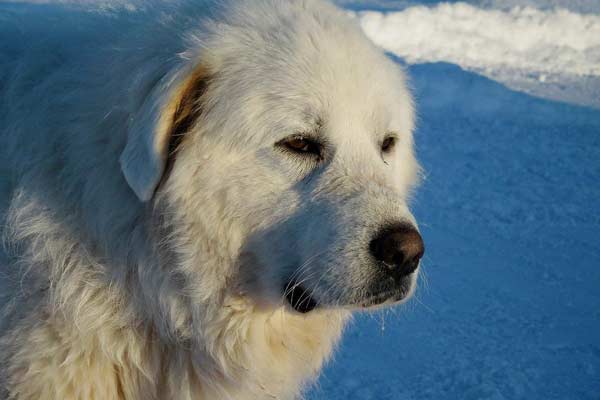15 Dogs Similar to Great Pyrenees: Finding Your Perfect Match

Ready to discover dogs that share the charm of the Great Pyrenees? From loyal Bernese Mountain Dogs to massive Saint Bernards, we’ll introduce you to breeds with similar traits and temperaments. Dive into this exciting exploration of potential furry companions!
Bernese Mountain Dog
The Bernese Mountain Dog and the Great Pyrenees are frequently likened to each other because they look alike and are similar in size.
However, there are some notable differences between the two breeds. Here are some key characteristics of the Bernese Mountain Dog:
Physical Characteristics
- Size: The Bernese Mountain Dog usually weighs between 70-115 pounds and stands about 23-28 inches high at the shoulder.
- Coat: Their coat is thick, long, and silky, with a tricolored pattern of black, white, and rust.
- Head: They have a broad, flat skull and a strong, square muzzle.
- Eyes: Their eyes are dark brown and almond-shaped.
- Ears: The Bernese Mountain Dog has medium-sized, triangular ears hanging close to their head.
- Tail: They have a bushy tail that is carried low.
Temperament
The Bernese Mountain Dog is known for being a gentle, loyal, and affectionate breed. They are great with children and make excellent family pets. They’re intelligent and keen to make you happy, making them simple to teach. But they can be headstrong at times, so regular training is crucial.
Health
Bernese Mountain Dogs, like other breeds, have specific health concerns. Common issues for this breed are:
- Hip dysplasia
- Elbow dysplasia
- Cancer
- Bloat
- Progressive retinal atrophy
To keep your Bernese Mountain Dog in good health, it’s essential to partner with a trustworthy breeder and have regular vet visits.
Saint Bernard
Saint Bernards are a large working dog breed originating in the Swiss Alps. They are known for their massive size, weighing between 120 to 180 pounds, and their gentle and friendly nature.
Saint Bernards have a thick coat that is typically white with markings of brown, red, or brindle.
Saint Bernards were first raised as guard dogs, similar to the Great Pyrenees. Monks in the Saint Bernard Pass trained them to help find and save travelers stuck in snowy conditions.
Saint Bernards have a strong sense of smell and can locate people buried in the snow.
Saint Bernards are great with children and make excellent family pets. They are calm, patient, and affectionate. However, due to their large size, they require a lot of space and exercise. Saint Bernards are not recommended for apartment living.
Saint Bernards need routine brushing to maintain a tangle-free and healthy coat. They also benefit from periodic baths. Since they tend to drool, owners should be ready to wipe up after them.
Greater Swiss Mountain Dog
The Swissy is a large dog from Switzerland. Initially, they helped with jobs like pulling carts and guarding animals. They’re gentle and patient, which makes them excellent pets for families.
Appearance
The Greater Swiss Mountain Dog is big. Males usually weigh 105-140 pounds, while females weigh 85-110 pounds. They have a thick, short coat that’s mainly black with some white and rust-colored spots. Their body is muscular, with a wide head and a flat nose.
Temperament
The Swissy are known for their calm and patient temperament. They are loyal and affectionate with their families and are great with children. They are also protective and make good watchdogs. They are intelligent and eager to please, making them relatively easy to train.
Health
The Greater Swiss Mountain Dog is usually healthy. However, they can have health problems like hip and elbow issues, stomach bloat, and eye troubles. Getting one from a trusted breeder who checks for these health concerns.
Similarities to the Great Pyrenees
The Great Pyrenees and the Greater Swiss Mountain Dog have some similarities. Both breeds were initially bred as working dogs and are known for their calm and patient temperaments.
They are also both protective of their families and make good watchdogs. However, the Great Pyrenees is a larger breed and is more commonly used as a livestock guardian dog, while the Swissy is more widely used as a cart-pulling and herding dog.
Leonberger
The Leonberger is a large and powerful breed of dog often compared to the Great Pyrenees due to their similar size and appearance. Here are some key features of the Leonberger breed:
- Size: Leonbergers are large dogs, typically weighing between 100 and 170 pounds and standing 25 to 31 inches tall at the shoulder. They are one of the largest breeds of dog.
- Appearance: The Leonberger has a thick, double coat that is usually a combination of black, brown, and tan. They have a broad head and a muscular, sturdy build.
- Temperament: Leonbergers are affectionate and kid-friendly, known for their loyalty, intelligence, and easy trainability, with a knack for getting along well with other pets.
- Health: Leonbergers, like other breeds, can have specific health concerns like hip problems, bloat, and heart issues. It’s crucial to pick a good breeder and get regular vet visits.
Newfoundland
The Newfoundland is a giant Canadian breed, reaching up to 150 pounds and 28 inches in height. Their thick coat comes in colors like black, brown, gray, or white-and-black, ideal for water activities.
Newfoundlands are often compared to Great Pyrenees due to their size and gentle nature. They are also known for their loyalty and are often used as rescue dogs due to their strength and swimming abilities.
Here are some critical differences between Newfoundland and the Great Pyrenees:
- Newfoundland has a shorter coat than Great Pyrenees, but it is still thick and requires regular grooming.
- Newfoundland is more prone to drooling than the Great Pyrenees.
- Newfoundland is a more social breed and enjoys being around people and other animals.
- The great Pyrenees are more independent and can be aloof with strangers.
- Newfoundland is easier to train than Great Pyrenees due to their eagerness to please.
Samoyed
Samoyed dogs are originated in Siberia. They are known for their thick, fluffy white coats and friendly, outgoing personalities. Samoyeds are often compared to Great Pyrenees due to their similar appearance, but they have distinct differences in personality and temperament.
Appearance
Samoyeds are medium-sized dogs, typically weighing between 35 and 65 pounds. They have a thick, double-layered coat that is white or cream. Their fur is long and fluffy, and they have a distinctive “smile” caused by the shape of their mouth.
Temperament
Samoyeds are friendly and love being around people, especially their families. They’re great with kids, which is why many families choose them. However, they can be stubborn and noisy sometimes, so they might not be ideal for apartment living.
Health
Samoyeds are usually healthy but can have specific health problems like hip issues, eye troubles, and skin allergies. To keep your Samoyed healthy, choose a good breeder and regularly visit the vet.
Maremma Sheepdog
The Maremma Sheepdog is a large, muscular breed that originated in Italy. They were bred to protect livestock, mainly sheep, from predators such as wolves and bears. Maremma Sheepdogs are similar to Great Pyrenees in appearance, with thick white coats and a strong, imposing presence.
Size and Appearance
Maremma Sheepdogs are slightly smaller than Great Pyrenees, with males standing around 26-28 inches tall and females around 25-27 inches. They weigh between 65-100 pounds, depending on their gender and build. Maremma Sheepdogs have a thick, double coat that is white or cream. Their fur is longer around the neck and shoulders, giving them a mane-like appearance.
Temperament
Maremma Sheepdogs are known for their loyalty and devotion to their family and work. They are intelligent and independent but also eager to please their owners. Maremma Sheepdogs are naturally protective and might be cautious around strangers. However, with the proper training, they can become friendly and social.
Grooming
Maremma Sheepdogs have high grooming requirements due to their thick, double coat. They shed heavily twice yearly and require regular brushing to prevent matting and tangling. They should also be bathed occasionally to keep their coat clean and healthy.
Health
Maremma Sheepdogs are usually healthy. However, they can have health problems like hip, stomach, and eye concerns. Buying these dogs from trusted breeders who check for these health problems is essential.
Training and Exercise
Maremma Sheepdogs are intelligent and like to make their owners happy. However, they can be a bit stubborn at times. Training and socializing them early is vital to avoid problems like being too aggressive or barking. They also need daily walks or runs to stay fit and cheerful.
Irish Wolfhound
The Irish Wolfhound is a giant breed similar to the Great Pyrenees. They are both large and gentle dogs that make excellent family pets. However, there are also some critical differences between the two breeds.
Appearance
The Irish Wolfhound is the world’s tallest dog breed, standing up to 7 feet tall on their hind legs. They have a long, narrow head with a pointed snout and long ears that hang down. Their coat is rough and wiry and can be any color, including fawn, red, white, grey, black, or brindle.
Temperament
Irish Wolfhounds are friendly and loving dogs. They adore their families and get along with kids and other animals. But, they can be shy around unfamiliar people.
Training and Exercise
Training an Irish Wolfhound can be tricky because they like doing things their way. They need lots of exercise and a big yard to run in. They also love going for long walks and hikes with their owners.
Health
Irish Wolfhounds are prone to specific health problems like all large breeds, including hip dysplasia, bloat, and heart disease. They also have a relatively short lifespan of around 6-8 years.
Pyrenean Mastiff
The Pyrenean Mastiff is a large, strong dog like the Great Pyrenees. It was bred in the 1970s to resemble old dogs from the Pyrenees Mountains.
Here are some key characteristics of the Pyrenean Mastiff:
- Size: Pyrenean Mastiffs are large dogs, typically weighing between 150 and 240 pounds. They can stand up to 31 inches tall at the shoulder.
- Coat: The Pyrenean Mastiff, similar to the Great Pyrenees, has a long, fluffy white or cream-colored coat. It needs regular grooming to stay clean and healthy.
- Temperament: Pyrenean Mastiffs are known for their calm, gentle temperament. They are loyal and protective of their family but can be reserved with strangers. They are generally good with children and other pets.
- Training: Pyrenean Mastiffs are intelligent dogs, yet they can sometimes be headstrong and like to do things their way. Training and socializing them early is vital to help them become well-mannered and responsive.
- Exercise: Pyrenean Mastiffs aren’t very active but need daily exercise to stay healthy and joyful. A walk or some playtime in the yard each day is usually enough.
Kuvasz
The Kuvasz is a large, muscular dog initially bred in Hungary to guard livestock. They are similar in appearance to the Great Pyrenees, but the two breeds have some critical differences.
Appearance
Kuvasz dogs are large, powerful animals weighing up to 115 pounds. They have a thick, white coat that is weather-resistant and helps to keep them warm in cold temperatures. Unlike the Great Pyrenees, the Kuvasz has a shorter, denser coat that requires less grooming.
Temperament
Kuvasz dogs are loyal and love to protect their families. Even though they can be stubborn, they are bright and want to make their owners happy. They’re great guard dogs and care about their families.
Training and Exercise
Kuvasz dogs need early training and socializing to grow up well-mannered. They’re bright and learn fast but can be a bit stubborn. It’s essential to be consistent during training. Regular exercise, like hiking and running, keeps them happy and healthy.
Health
Kuvasz dogs are usually healthy, but like all breeds, they can have common health problems such as hip dysplasia, bloat, and eye issues. Regular vet visits and a good diet can help prevent these.
Great Dane
Great Danes are among the world’s largest dog breeds, only surpassed by Irish Wolfhounds. They’re nicknamed “gentle giants” because of their friendly and loving demeanor. These dogs are famous for their huge size, with males reaching a minimum of 30 inches in shoulder height and weighing up to 200 pounds.
Appearance
Great Danes have a sleek and muscular build, with a short coat in various colors, including fawn, brindle, blue, black, and harlequin. They have a long and narrow head with a pronounced brow and floppy ears that can be cropped or left natural. Their eyes are usually dark and almond-shaped.
Temperament
Great Danes, despite their size, are gentle and affectionate family pets. They’re loyal and protective but may be cautious around strangers. They usually get along well with kids and other pets, though their size can be a concern around small children or animals. Early socialization and training are vital due to their occasional stubbornness.
Health
Great Danes often face health challenges such as hip dysplasia, bloat, and heart issues. They typically live for 6-8 years on average. To keep them healthy, owners should watch their weight and ensure they get appropriate exercise.
Comparison to the Great Pyrenees
While Great Danes share some similarities with the Great Pyrenees, such as their large size and protective nature, they have different temperaments and health concerns.
The Great Pyrenees are known for their independent and stubborn nature, while the Great Danes are more affectionate and trainable. Additionally, Great Pyrenees have a longer lifespan and are generally healthier than Great Danes.
Dogue de Bordeaux
The Dogue de Bordeaux, also called the French Mastiff, hails from France and is a giant, strong breed similar to the Great Pyrenees. They sport a shorter coat and come in shades like red, brown, and fawn.
Appearance
The Dogue de Bordeaux is easily recognizable due to its prominent features, including a massive head and a wrinkled face. Their short coat requires minimal grooming. This breed boasts impressive size and strength, with some males weighing up to 110 pounds and reaching a height of 27 inches at the shoulder.
Temperament
The Dogue de Bordeaux is a faithful and watchful dog, perfect as a guard dog. They’re usually calm and kind but can be strong-willed at times. Training and socializing them early is vital to ensure they’re friendly.
Health
Like other dog breeds, the Dogue de Bordeaux can have health problems like hip issues, heart troubles, and skin allergies. It is essential to get one from a trusted breeder who checks their dogs for these issues.
Exercise and Training
The Dogue de Bordeaux is a calm dog that doesn’t need a lot of exercise. But, they should have regular walks and play to be healthy and joyful. They are smart but can be stubborn, so it’s essential to train and socialize them early on.
Similarities to the Great Pyrenees
The Dogue de Bordeaux and Great Pyrenees are large, muscular breeds initially bred for guarding and protecting. They are loyal and protective of their families, making them excellent guard dogs.
However, the Great Pyrenees has a longer coat and is primarily white, while the Dogue de Bordeaux has a shorter coat and comes in various colors.
Anatolian Shepherd
The Anatolian Shepherd is a large dog that originated in Turkey. They were bred to be livestock guardians and have a protective nature. They are similar in size and temperament to the Great Pyrenees, making them a good alternative for those looking for a similar breed.
Appearance
Anatolian Shepherds are large dogs, typically standing 27 to 29 inches tall and weighing between 80 to 150 pounds. They come in various colors, including fawn, brindle, and white, and have a sturdy appearance with a broad head and a muscular body.
Temperament
Anatolian Shepherds are known for their protective nature and loyalty to their family. They are intelligent and independent, making them a good choice for experienced dog owners. They are also calm and patient, making them good with children. However, they can be wary of strangers and other animals, so early socialization is essential.
Health
Anatolian Shepherds are usually healthy but can have specific health problems like hip issues, stomach bloat, and eye troubles. Buying from a trusted breeder and visiting the vet regularly is essential to keep your dog in good shape.
Training and Exercise
Anatolian Shepherds are intelligent and usually trainable but can be a bit headstrong. So, it’s essential to provide consistent training. These dogs need plenty of exercise, making them ideal for homes with spacious yards or rural settings where they can roam and play freely.
Tibetan Mastiff
The Tibetan Mastiff is a large dog from Tibet. They are known for their impressive size, thick coat, and protective nature. Here are some key characteristics of the Tibetan Mastiff:
- Size: Tibetan Mastiffs are big dogs, with males typically weighing 100-160 pounds and females 70-120 pounds, reaching up to 28 inches in shoulder height.
- Coat: The Tibetan Mastiff’s coat is thick with either a straight or slightly wavy texture. It can come in black, brown, blue/grey colors, possibly with white markings.
- Temperament: Tibetan Mastiffs are renowned for their loyalty and protective nature towards their family, making them excellent guard dogs. They tend to be cautious around strangers and other animals. Their independent and stubborn traits emphasize the importance of early socialization and training.
- Exercise: Tibetan Mastiffs aren’t very active but still need daily exercise, typically a daily walk or playtime in the yard to stay healthy.
- Health: Tibetan Mastiffs are usually in good health, but like any dog breed, they can develop specific health problems like hip dysplasia, elbow dysplasia, and eye issues. Regular vet visits and a balanced diet can help prevent these issues.
White Swiss Shepherd
The White Swiss Shepherd, also known as the Berger Blanc Suisse, is a breed that originated in Switzerland. It is a large, muscular dog that is similar in appearance to the Great Pyrenees, with a thick white coat and a sturdy build.
The White Swiss Shepherd, much like the Great Pyrenees, was initially bred as a working dog for herding and guarding livestock. Its loyal and affectionate nature has made it a popular choice as a companion dog.
Here are some key characteristics of the White Swiss Shepherd:
- Size: These dogs are big, with males usually weighing 65-90 pounds and females 55-75 pounds.
- Coat: The White Swiss Shepherd has a dense white double coat that needs regular grooming to prevent matting and tangling.
- Temperament: White Swiss Shepherds are intelligent, loyal, and protective. They are typically good with children and other pets if socialized properly.
- Health: Like any other breed, White Swiss Shepherds can be susceptible to specific health problems, such as hip and elbow dysplasia.









